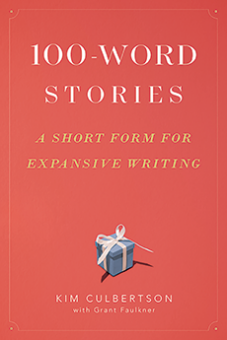100-Word Stories: A Short Form for Expansive Writing
By Kim Culbertson with Grant Faulkner
(Heinemann, 2024 – Learn more)
Reviewed by Melinda Stewart
 Kim Culbertson’s 100-Word Stories offers a unique and compact journey through storytelling, presenting narratives distilled into their essence – each composed of 100 words.
Kim Culbertson’s 100-Word Stories offers a unique and compact journey through storytelling, presenting narratives distilled into their essence – each composed of 100 words.
As an educator working with multilingual learners, most of whom are new to English, I was curious about this resource. I found this book to be a delightful and versatile tool for fostering language proficiency, creativity, and cultural exchange in the classroom.
Culbertson’s approach to storytelling in such a concise format challenges both students and educators to distill complex ideas into succinct narratives. This format is particularly beneficial to multilingual learners as it encourages a focus on clarity and precision in language use.
 Each story serves as a model of concise writing, demonstrating how impactful storytelling can be achieved with brevity. The book’s subtitle tells us that it addresses “a short form for expansive writing,” but truth be told, it is so clearly written with such good examples that I am looking forward to using the content as a resource in the reading course I will be teaching this upcoming school year.
Each story serves as a model of concise writing, demonstrating how impactful storytelling can be achieved with brevity. The book’s subtitle tells us that it addresses “a short form for expansive writing,” but truth be told, it is so clearly written with such good examples that I am looking forward to using the content as a resource in the reading course I will be teaching this upcoming school year.
Accessible for SLIFE along with other students
One of the strengths of 100-Word Stories lies in its accessibility. The brevity of each story makes them manageable for students at different proficiency levels in English and other languages. For multilingual students, these stories serve as a springboard for language practice, allowing them to build their schema as they engage with the nuances of vocabulary, syntax, and narrative structure in a manageable context.
The diversity of themes and topics covered in the collection provides rich material for discussion. Each story offers a glimpse into different perspectives and experiences, which have the potential to spark meaningful conversations among students.
Adaptable to support varied literacy activities
As an instructional tool, 100-Word Stories can be adapted in numerous ways to support language and literacy development. The stories and other materials can be downloaded at the publisher’s site. Educators can use these stories for reading comprehension activities, vocabulary expansion exercises, writing prompts, and even collaborative storytelling projects. The brevity of each story lends itself well to repeated readings. A note from the authors acknowledges the challenge of selecting stories for a book aimed at grades 5-12: “We tried to include at least one story in each section that could work for each concept at any grade level, five through twelve.”
Much of the curriculum that my SLIFE (students with limited or interrupted formal education) students encounter in the mainstream classroom is beyond their current reach and weeks of frustration with little to no understanding ensue. At 100 words per story, Culbertson’s examples model essential learning at a length that is learner friendly. I anticipate that by using these stories not only to teach writing but to teach reading, I will more aptly be able to instill an interest in reading and build a sense of learner agency.
Supports engagement with content
Each story in the collection touches on universal themes that resonate across cultures. By discussing and interpreting these themes in the context of their own experiences, students can deepen their understanding of the stories and their own identities. This process encourages students to appreciate the power of storytelling and the intricacies of language use, promoting deeper engagement with the content.
While Culbertson’s collection excels in its versatility and pedagogical potential, it could benefit from supplementary materials or additional guidance specifically tailored for educators working with multilingual secondary students. Additional resources on how to scaffold learning experiences around these stories, particularly for those students at different language proficiency levels and from different cultural backgrounds to the characters in the stories, would enhance its practical application in diverse educational settings.
Kim Culbertson’s 100 Word Stories is a valuable resource that provides a structured yet flexible framework that serves as a tool to enrich language instruction and a catalyst for exploration and creative expression in the classroom.
Melinda Stewart has been an educator for 30 years. She has an MA in Teaching, Education and Learning and has done graduate work in the areas of English as a Second Language, Reading, and Spanish. She is currently working as a Spanish teacher and ELM coach at Fairmont Junior Senior High School. Melinda is an MEA and AFT professional development facilitator and trainer who has a deep passion for learning and equity.


